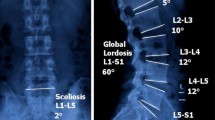Abstract
Introduction
Little is known about when and how progressive spondylolisthesis occurs. In this report segmental motion related to age and disc degeneration at L4/5 disc was investigated.
Materials and methods
637 patients with low back and/or leg pain underwent radiologic and MRI examinations simultaneously. Because 190 patients with conditions which might impede accurate measurement were excluded, 447 patients, comprising 268 men and 179 women, were included; age range, was 10–86 (mean: 53) years. Three radiologic parameters slip in neutral position (mm), sagittal translation (mm), and segmental angulation (degrees) were examined at the L4/5 segment. On T2-weighted MRI, severity of disc degeneration at L4/5 was classified by Pfirrmann’s criteria, grade 1-5.
Results
Results showed stage of disc degeneration that progressed according to aging with significant differences except for between grades 4 and 5. Amount of anterior slip was small among grades 1 to 3; however, it greatly increased between grades 3 and 4 and between grades 4 and 5, suggesting that grade 3 disc degeneration has a potential risk of future progression of anterior slip. This finding may also suggest that once significant slip occurs, it will progress to the final grade. Furthermore, the grade 3 degeneration group exhibited large amounts of motion in both angulation and translation, suggesting it was the most unstable group.
Conclusion
Our results with radiography and MRI indicate that grade 3 disc degeneration is a critical stage for the progression of lumbar spondylolisthesis at L4/5 segment.




Similar content being viewed by others
References
Axelsson P, Karlsson BS (2004) Intervertebral mobility in the progressive degenerative process. A radiostereometric analysis. Eur Spine J 13:567–572
Boos N, Weissbach S, Rohrbach H et al (2002) Classification of age-related changes in lumbar intervertebral discs. Spine 27:2631–2644
Brown MD, Holmes DC, Heiner AD et al (2002) Intraoperative measurement of lumbar spine motion segment stiffness. Spine 27:954–958
Eifering A, Semmer N, Birkhofer D et al (2002) Young investigator award 2001 winner: risk factors for lumbar disc degeneration. Spine 27:125–134
Henchoz Y, Goumoëns PD, Norberg M et al (2010) Role of physical exercise in low back pain rehabilitation. Spine 35:1192–1199
Iguchi T, Kanemura A, Kasahara K et al (2003) Age distribution of three radiological factors for lumbar instability: probable aging process of the instability with disc degeneration. Spine 28:2628–2633
Iguchi T, Ozaki T, Chin T et al (2011) Intimate relationship between instability and degenerative signs at L4/5 segment examined by flexion–extension radiography. Eur Spine J 20:1349–1354
Kanemura A, Doita M, Kasahara K et al (2009) The influence of sagittal instability factors on clinical lumbar spinal symptoms. J Spinal Disord Tech 22:479–485
Khoueir P, Black MH, Crookes PF et al (2009) Prospective assessment of axial back pain symptoms before and after bariatric weight reduction surgery. Spine J 9:454–463
Kim NH, Lee JW (1995) The relationship between isthmic and degenerative spondylolisthesis and the configuration of the lamina and facet joints. Eur Spine J 4:139–144
Kirkaldy-Willis WH, Farfan HF (1982) Instability of the lumbar spine. Clin Orthop 165:110–123
Kong MH, Hymanson HJ, Song KY et al (2009) Kinetic magnetic resonance imaging analysis of abnormal segmental motion of the functional spine unit. J Neurosurg Spine 10:357–365
Leone A, Guglielmi G, Cassar-Pullicino VN et al (2007) Lumbar intervertebral instability: a review. Radiology 245:62–77
Love TW, Fagan AB, Fraser RD (1999) Degenerative spondylolisthesis, developmental or acquired? J Bone Joint Surg B 81:670–674
Luoma K, Riihimäki H, Luukkonen R et al (2000) Low back pain in relation to lumbar disc degeneration. Spine 25:487–492
Murata M, Morio Y, Kuranobu K (1994) Lumbar disc degeneration and segmental instability: a comparison of magnetic resonance images and plain radiographs of patients with low back pain. Arch Orthop Trauma Surg 113:297–301
Ochia RS, Inoue N, Takatori R et al (2007) In vivo measurements of lumbar segmental motion during axial rotation in asymptomatic and chronic low back pain male subjects. Spine 32:1394–1399
Paajanen H, Erkintalo M, Dahlström S et al (1989) Disc degeneration and lumbar instability. Acta Orthop Scand 60:375–378
Peterson CK, Bolton JE, Wood AR (2000) A cross-sectional study correlating lumbar spine degeneration with disability and pain. Spine 25:218–223
Pfirrmann CWA, Metzdorf A, Zanetti M et al (2001) Magnetic resonance classification of lumbar intervertebral disc degeneration. Spine 26:1873–1878
Shaffer WO, Spratt KF, Weinstein J et al (1990) The consistency and accuracy of roentgenograms for measuring sagittal translation in the lumbar vertebral motion segment: an experimental model. Spine 15:741–750
Shirado O, Doi T, Akai M et al (2010) Multicenter randomized controlled trial to evaluate the effect of home-based exercise on patients with chronic low back pain. Spine 35:E811–E819
Urquhart DM, Berry P, Wluka AE et al (2011) Increased fat mass is associated with high levels of low back pain intensity and disability. Spine 36:1320–1325. doi:10.1097/BRS.0b013e3189f9fb66
Acknowledgments
The authors thank Ms. Janina Tubby for help in preparing the manuscript. No funds were received in support of this study.
Conflict of interest
None.
Author information
Authors and Affiliations
Corresponding author
Rights and permissions
About this article
Cite this article
Iguchi, T., Nishida, K., Ozaki, T. et al. Grade three disc degeneration is a critical stage for anterior spondylolisthesis in lumbar spine. Eur Spine J 21, 2134–2139 (2012). https://doi.org/10.1007/s00586-012-2288-x
Received:
Revised:
Accepted:
Published:
Issue Date:
DOI: https://doi.org/10.1007/s00586-012-2288-x




